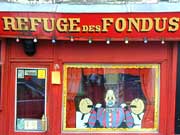Being an ex-New Yorker, I'm a little sad today as I watched the last game played ever at Yankee Stadium. They are tearing down the stadium & building a new one (but not on the same exact spot) for next year. It makes me sad not only because I'm a die-hard Yankee fan, but also as a realization that in America, unlike Europe, we don't value our historical buildings & landmarks. 3,000 years from now we won't have our historical landmarks here. But Europe will always have Notre Dame, the Coliseum, the Parthenon, etc.
Anyway I found this article in the french newspaper "Le Figaro"
Les New-Yorkais pleurent la fin du Yankee Stadium(New Yorkers Mourn The End Of Yankee Stadium)
Dimanche, le plus célèbre terrain de base-ball accueillera son dernier match avant sa démolition.
Mais pour l'instant, l'heure est à la nostalgie. C'est dimanche que le plus célèbre terrain de base-ball au monde doit accueillir son dernier match, avant d'être démoli, à 85 ans. ll y a plus d'histoire dans le Yankee Stadium que dans toute l'histoire de France, pour moi ce n'est pas un stade, c'est une cathédrale.
Les plus grandes légendes Toute cette semaine, nombre de fans sont donc venus faire leurs adieux au fameux stade.
Si l'actuel Yankee Stadium occupe une place à part dans le cœur des Américains, c'est qu'il est intimement lié à l'histoire du pays. Il a vu naître les plus grandes légendes du base-ball, le sport le plus populaire aux États-Unis. Il a accueilli Eisenhower, Billy Joel, les Pink Floyd, le pape Jean-Paul II et même George W. Bush après les attentats du 11 Septembre. L'émotion est donc à fleur de peau dans les gradins, au moment du traditionnel God Bless America. La casquette bleue au fameux sigle posée pour l'occasion sur la poitrine, les fans chantent, le regard plein de fierté.
Translation:
Sunday, the most famous baseball field will host its last game before its demolition.
But for now, time is the nostalgia. Sunday the most famous baseball field in the world will host its last match before being demolished in 85 years. There is more history in Yankee Stadium in the history of France, for it is not a stage is a cathedral.
The greatest legends
All this week, many fans are coming to say goodbye to the famous stadium.
If the current Yankee Stadium holds a special place in the heart of Americans, it is intimately linked to the country's history. He has seen the greatest legends of baseball, the most popular sport in the United States. He welcomed Eisenhower, Billy Joel, Pink Floyd, Pope John Paul II and even George W. Bush after the attacks of Sept. 11. The emotion is flush skin in the stands, when traditional God Bless America. The blue cap raised to the famous acronym for the occasion on his chest, the fans sing, eyes full of pride.





.jpg)





















